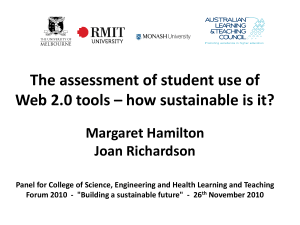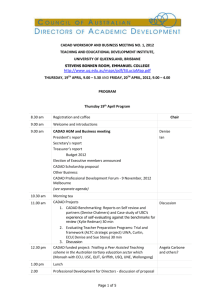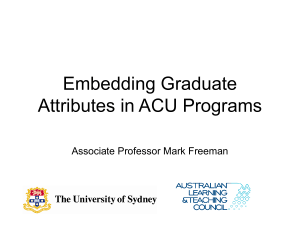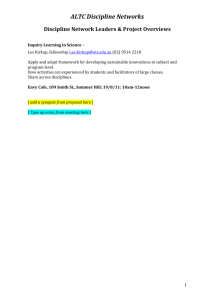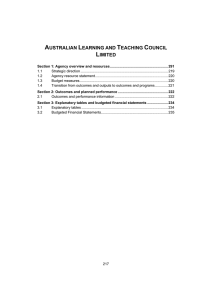Using the Australian criteria for peer review
advertisement
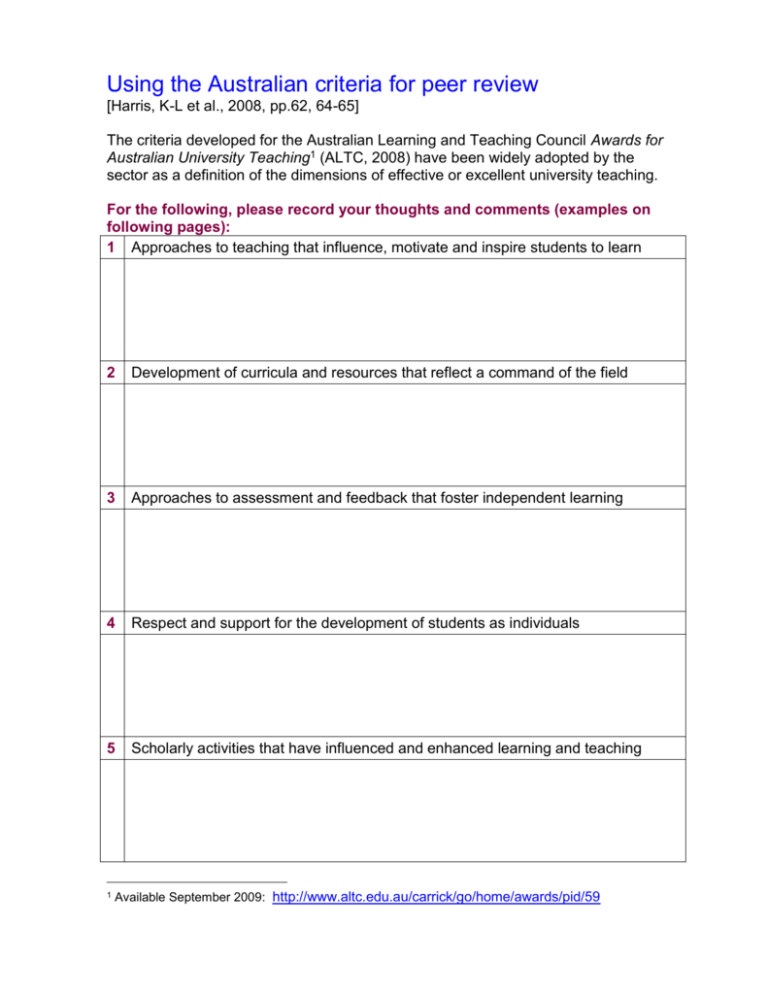
Using the Australian criteria for peer review [Harris, K-L et al., 2008, pp.62, 64-65] The criteria developed for the Australian Learning and Teaching Council Awards for Australian University Teaching1 (ALTC, 2008) have been widely adopted by the sector as a definition of the dimensions of effective or excellent university teaching. For the following, please record your thoughts and comments (examples on following pages): 1 Approaches to teaching that influence, motivate and inspire students to learn 2 Development of curricula and resources that reflect a command of the field 3 Approaches to assessment and feedback that foster independent learning 4 Respect and support for the development of students as individuals 5 Scholarly activities that have influenced and enhanced learning and teaching 1 Available September 2009: http://www.altc.edu.au/carrick/go/home/awards/pid/59 Examples of criteria that may give rise to thoughts and comments: 1. Approaches to teaching that influence, motivate and inspire students to learn For example: Effectively encouraging student participation Generating student interest in the subject Use of examples relevant to students’ interest and experiences Incorporating current and relevant ‘real-world’ examples Modelling of critical thinking and problem-solving Use of activities that require students to take a critical approach to the task Demonstrating enthusiasm for learning in the discipline Effective communication skills High-level interpersonal skills Rapport and engagement with students Skilful presentation of ideas and information (including effective use of audiovisual material) Structure of the learning activity Developing students’ scholarly values Encouraging students to take responsibility for their own learning Helping students become reflective learners Management of the audience Effectiveness of questioning techniques Facilitating links between practice and theory (for clinical/practical demonstrations) 2. Development of curricula and resources that reflect a command of the field For example: Effective use of teaching and learning resources Current research is integrated within the teaching Demonstrated command of the subject matter Evidence of sound planning of learning opportunities for students Content is relevant, accurate and current Appropriate use is made of online learning opportunities The learning encouraged supports the development of the desired graduate attributes Expectations are clearly communicated to students Clear communication of learning task and assessment objectives Effective use of interactive technologies in the design of learning tasks Engagement of community expertise and experience in the design of curricula and resources Learning activities and resources accommodate the skills, knowledge and experience of commencing students 3. Approaches to assessment and feedback that foster independent learning For example: Assessment tasks align with the stated learning outcomes for the subject Students have opportunities to practice the skills to be assessed Students have opportunities to self-assess in preparation for major assessment tasks Timely and constructive feedback is provided The tasks allow students to demonstrate their knowledge and skills Appropriate involvement of external expertise in student assessment Suitable methods are used to identify and monitor student progress The teaching encourages reflective practice and self-assessment Students encouraged to take responsibility for monitoring their own learning Assessment encourages and rewards creativity 4. Respect and support for the development of students as individuals For example: Effective strategies for monitoring students’ progress Involving students in development of the curriculum and/or teaching activities Are opportunities for students to seek advice and assistance from the teacher Consideration is given to the diverse learning needs of students An inclusive and supportive learning environment is fostered Students are afforded respect, thereby encouraged to respect peers and staff Consideration of students’ aspirations and priorities Equal opportunities exist for all students 5. Scholarly activities that have influenced and enhanced learning and teaching For example: Evidence of reflective practice with regard to teaching and learning Contribution to the advancement of teaching and learning in the discipline Leadership in curriculum renewal Leadership in the enhancement of assessment practices, including academic standards Support for the development of the teaching of peers Fostering a scholarly approach to teaching among peers Rigorous and thoughtful investigation of student learning Knowledge transfer activities that enrich the curriculum References: Australian Learning and Teaching Council (ALTC). (2008). Teaching Awards. Last accessed 30 September 2009: http://www.altc.edu.au/carrick/go/home/awards/pid/59 Harris, K-L., Farrell, K., Bell, M., Devlin, M., James, R. (2008) Peer Review of Teaching in Australian Higher Education. Last accessed 30 September 2009: http://www.cshe.unimelb.edu.au/pdfs/PeerReviewHandbook_eVersion.pdf
